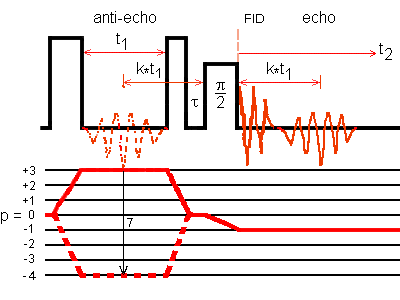
Phase-modulated multiplex z-filter pulse program for MQMAS from Fernandez, Malicki, and Mafra
Malicki and coworkers [Multiplex MQMAS NMR of quadrupolar nuclei, Solid State Nucl. Magn. Reson. 28, 13-21 (2005)] incorporate the multiplex acquisition approach with the z-filter MQMAS sequence. The sequence becomes a phase-modulated one. There are 4I+1 phases for the first pulse. The second pulse is an x-pulse. The third pulse and the receiver have the same phases (two or four phases are applied, depending on the strength of the RF magnetic field).
In contrast to the original method proposed by Gan and Kwak [ Enhancing MQMAS sensitivity using signals from multiple coherence transfer pathways, J. Magn. Reson. 168, 346-351 (2004)] which is a multiplex acquisition on the third pulse, the method of Malicki and coworkers is a multiplex acquisition on the first pulse.
For each t1 value of the MQ evolution period, 4I+1 time-domain signals Sk(t1, t2) are acquired and stored individually.
The echo signal associated with coherence order p is provided by

The antiecho signal associated with coherence order -p is provided by


Fig. 1: Multiplex z-filter 3QMAS NMR pulse sequence and antiecho transfer pathway for a spin I = 3/2.
For a spin I = 3/2, the echo signal Fp=-3(t1, t2) associated with the coherence transfer pathways 0Q -> -3Q -> 0Q -> -1Q is obtained from the seven experimental signals Sk(t1, t2).
Similarly, the antiecho signal F-p=3(t1, t2) associated with the coherence transfer pathways 0Q -> 3Q -> 0Q -> -1Q is also obtained from these seven experimental signals Sk(t1, t2).
; mq3qzqfmultiplex ; phase-modulated z-filter MQMAS sequence ; associated with multiplex acquisition approach, ; excitation(3Q) - conversion(0Q) - tau - 90sel - ACQ(-1Q), ; 3Q MAS pulse program for nuclei with half-integer quadrupole spin, ; The generated 3D data have to be processed with the AU program: ; MMQ (Multiplex MQ) provided by Fernandez and coworkers, ;parameters: ;PARMODE : 3D ;AQORDER : 3-2-1 ;ns : 4*n ;d1 : recycle delay ;p1 : excitation pulse at pl11 ;p2 : conversion pulse at pl11 ;p3 : 90 degree selective pulse at pl13 ;pl1 : = 120 dB (not used) ;pl11 : power level for excitation and conversion pulse ;pl13 : power level for selective pulse, ca. Pl11 + 30 dB ;d0 : = 1u or longer ;in0 = 1n10 : 1 rotor period for synchronised experiment ;td3 : 256*n (= TD2 in a 2D z-filter MQMAS experiment) ;td2 : number of rows acquired in the MQ dimension ; (= TD1/2 in a 2D z-filter MQMAS experiment) ;td1 : = 7 for 3/2-spin, 11 for 5/2-spin, and 15 for 7/2-spin ;FnMODE : undefined ;Number of rows to acquire in the MQ dimension define loopcounter nrows "nrows=td2" ;Number of individual spectra define loopcounter np "np=td1" 1 ze ; clear memory, new data replace old data, ; switch AD converter to replace mode, ; perform DS before next acquisition, 2 d1 ; recycle delay, 10u pl11:f1 ; 10 microsecond delay, ; set high power in f1 channel, ; ---------- Sequence MQMAS (3 pulses) 1.7u:f1 ph1 ; preset the ph1 phase, (p1 ph1):f1 ; high-power excitation pulse, d0 ; MQ evolution period, 1.7u:f1 ph2 ; preset the ph2 phase, (p2 ph2):f1 ; high-power conversion pulse, 10u pl13:f1 ; set low power in f1 channel, 1.7u:f1 ph3 ; preset the ph3 phase, (p3 ph3):f1 ; 90° selective pulse, ;------------ Acquire go=2 ph31 ; signal acquisition, increment the ph3 ; and ph31 phases but not the ph1 phase, ; loop to 2, ns times for averaging, 10m wr #0 if #0 zd ; delay for disk I/O, store signal, ; write individuel FIDs, ; increase FID number, ; delete memory data, ; do not perform dummy scans ; with next acquisition, ;---np phase experiments for multiplex of the first pulse 10m ip1 ; increment the ph1 phase for multiplex, lo to 2 times np ; loop to 2 for acquisition of np phases ;---- Perform time evolution in the MQ dimension 10m rp1 ; reset the ph1 phase to 0°, 10m id0 ; increment d0, lo to 2 times nrows ; loop to 2 for nrows in MQ dimension, exit ; end of the pulse program ; 7 phases for the 3QMAS on 3/2 nucleus (set TD1=7) ; Comment this line for 5/2 nucleus ph1=(7) 0 ; excitation pulse phase ; 11 phases for the 3Q and 5QMAS on 5/2 nucleus (set TD1=11) ; Uncomment the following line for 5/2 nucleus ; ph1=(11) 0 ph2= 0 ; conversion pulse phase ph3= 0 1 2 3 ; 90° selective pulse phase if ns = 4*n ph31= 0 1 2 3 ; receiver phase if ns = 4*n ; if the third pulse is a true selective pulse, we can apply ; the following phase cycling, with ns = 2*n, ;ph3= 0 2 ; 90° selective pulse phase, ;ph31= 0 2 ; receiver phase